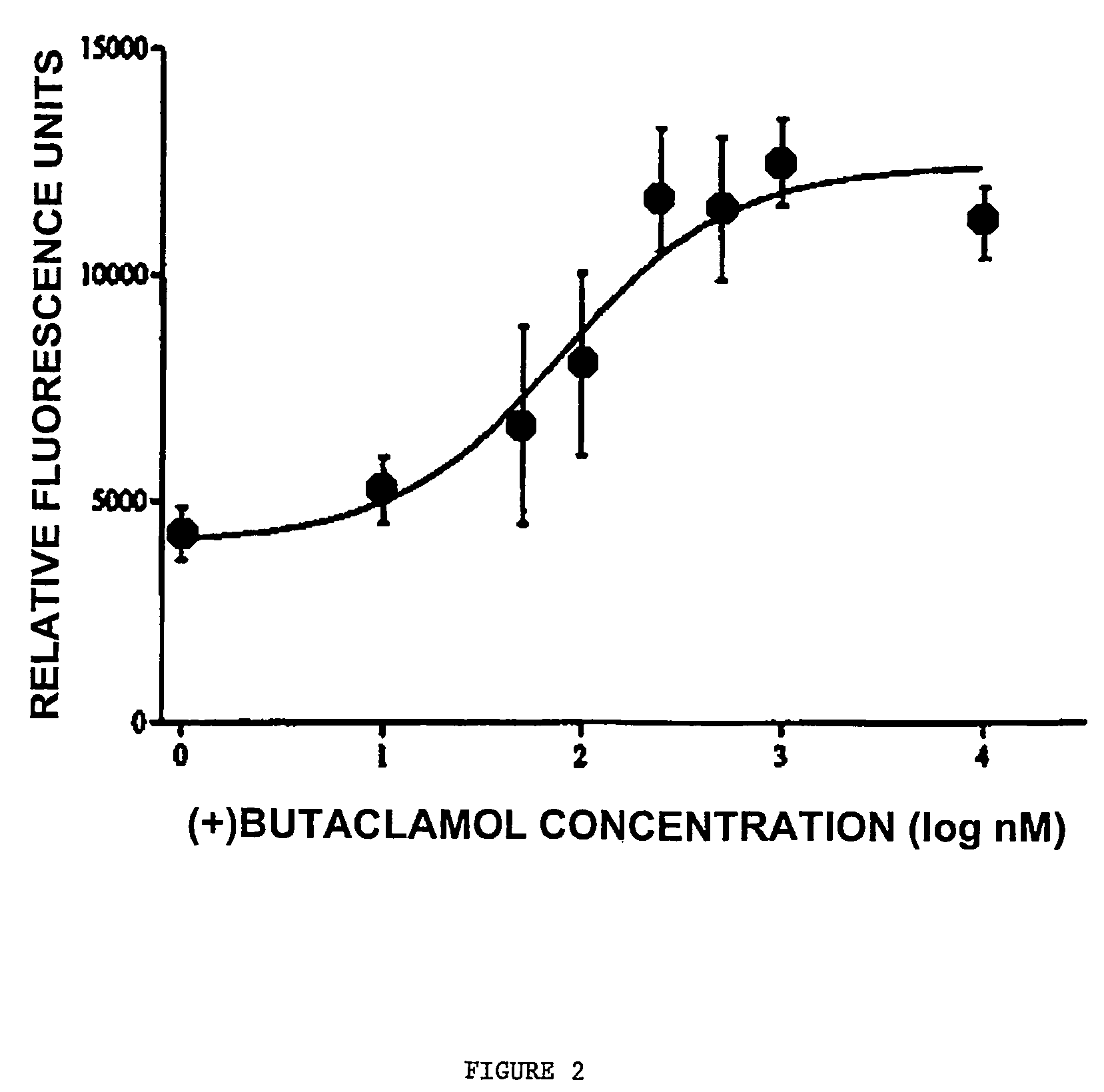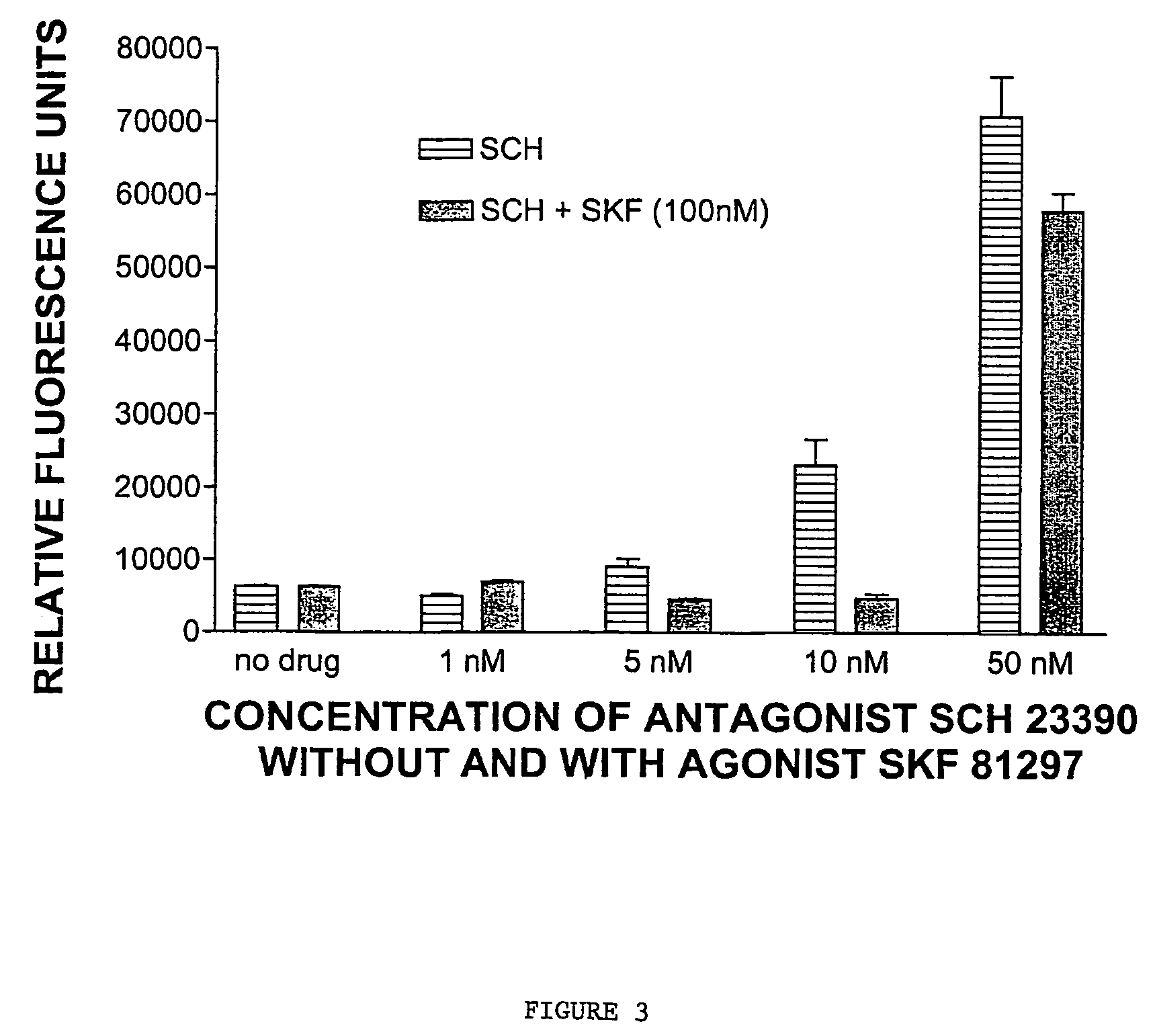Method of identifying transmembrane protein-interacting compounds
a technology of transmembrane protein and interacting compounds, which is applied in the direction of growth factor/regulator receptors, assay labels, peptides, etc., can solve the problems of limiting the utility of some existing ligand-identification assays, protein translocation requires complex computerised analytical technologies, and pharmaceutical houses are experiencing a dearth of promising lead compounds
- Summary
- Abstract
- Description
- Claims
- Application Information
AI Technical Summary
Benefits of technology
Problems solved by technology
Method used
Image
Examples
example 1
Dopamine D1 Receptor Fused to the Red Fluorescent Protein (D1-RFP) or Containing a NLS and Fused to the Red Fluorescent Protein (D1-NLS-RFP)
[0339]The sequence of the dopamine D1 receptor, which does not contain an NLS, was modified to replace the amino acids DFRKA at the base of TM7 domain with the NLS sequence KKFKR (which corresponds to the NLS of the human AT1 receptor), as described in the methods (see FIG. 1). DNA constructs were created encoding the D1 dopamine receptor fusion proteins D1-RFP and D1-NLS-RFP. COS cells were transfected with DNA encoding D1-NLS-RFP or D1-RFP (2 micrograms) and incubated for 24 and 48 hours. The cells were examined by confocal microscopy at 100× magnification. Cells were counted manually in 8 to 10 microscopic fields and the percentage labelling in different subcellular compartments was calculated.
[0340]At 24 and 48 hours, cells transfected with D1-RFP showed expression at the cell surface in the majority of cells, whereas cells transfected with ...
example 2
Dopamine D1 Receptor Fusion Protein Containing a NLS (D1-NLS-RFP) Treated with Antagonist
[0341]COS cells were transfected with a construct encoding D1-NLS-RFP and with wildtype D1 (2 micrograms) for 48 hours. At 6, 22, 30 and 42 hours after transfection, the cells were treated with the dopamine D1 receptor antagonist SCH23390 (final concentration 10 micromolar). Also at 6, 22, 30 and 42 hours after transfection, cells were treated with the antagonist (+)butaclamol (final concentration 10 μM). Control cells received no antagonist treatment.
[0342]At 48 hours, the majority of control cells had detectable D1-NLS-RFP in the nucleus. In contrast, the majority of antagonist-treated cells had fluorescence only on the cell surface, while 42% had fluorescence both on the surface and in the nucleus.
example 3
Dopamine D1 Receptor (D1-GFP) Co-Expressed with D1 Receptor Containing a NLS (D1-NLS)
[0343]HEK cells were transfected with DNA constructs encoding D1-NLS (3 micrograms) and / or D1-GFP (1.5 micrograms), and incubated for 48 hours. The cells were also transfected with a plasmid encoding DsRed-NUC to verify the localisation of the nucleus (1 microgram).
[0344]Cells were also transfected with DNA encoding D1-GFP (2 micrograms), incubated for 48 hours and examined by confocal microscopy.
[0345]D1-GFP expressed alone revealed that 90% of the cells demonstrated cell surface labelling and 10% showed both nuclear and cell surface labelling. With any DNA encoding a GPCR transfection, up to 10% of cells may be observed with a nuclear localisation.
[0346]Cells expressing D1-GFP and D1-NLS showed 35% of cells with both nuclear and cell surface labelling and 70% with receptor-expression on cell surface only. This experiment indicated that D1-GFP co-trafficked with D1-NLS resulting from oligomerisatio...
PUM
| Property | Measurement | Unit |
|---|---|---|
| time | aaaaa | aaaaa |
| time | aaaaa | aaaaa |
| time period | aaaaa | aaaaa |
Abstract
Description
Claims
Application Information
 Login to View More
Login to View More - R&D
- Intellectual Property
- Life Sciences
- Materials
- Tech Scout
- Unparalleled Data Quality
- Higher Quality Content
- 60% Fewer Hallucinations
Browse by: Latest US Patents, China's latest patents, Technical Efficacy Thesaurus, Application Domain, Technology Topic, Popular Technical Reports.
© 2025 PatSnap. All rights reserved.Legal|Privacy policy|Modern Slavery Act Transparency Statement|Sitemap|About US| Contact US: help@patsnap.com



